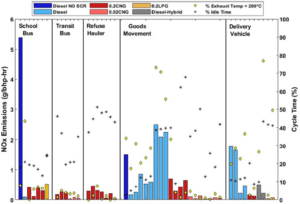In-use NOx emissions from heavy-duty trucks and buses
Journal Paper Review : Real-world NOx emissions from heavy-duty diesel, natural gas, and diesel hybrid electric vehicles of different vocations on California roadways
Science of the Total Environment 784 (2021) 147224
Background
This is one of the largest studies in California on measurement of in-use NOx emissions from 50 heavy-duty trucks and buses for various vocations. The fleet included 2 diesel vehicles without SCR (selective catalytic reduction of NOx), 14 diesels with SCR, 2 diesel hybrids, 29 compressed natural gas (CNG) and 3 liquified petroleum gas (LPG) vehicles. Emissions were measured using portable emissions measurement systems (PEMS) and on actual driving routes and applications (e.g. transit buses making stops and refuse trucks making the rounds collecting garbage and delivering to landfills). All vehicles had less than 435,000 miles of prior driving, so that these were within the useful life requirements.
This is a good database to identify future potential of advanced powertrain & after-treatment technologies as we move towards the Low NOx regulations starting 2024 – 2027.
Key Takeaway (1)
Compared to diesel vehicles with SCR technology, CNG vehicles certified to 0.02 g/bhp-h standard emitted 94% lower NOx. LPG vehicles lowered emissions by 79%, while diesel hybrids offered a reduction of 65%.
Key Takeaway (2)
NOx emissions depend not only on exhaust temperature, but also on driving pattern. Start-stop driving and accelerations were found to contribute to most of the NOx emissions even when exhaust temperatures were > 200 C (at which SCR is active). Emissions were higher at low load, low speed driving, which has been noted in many previous studies and is the background for the low load driving cycle in the upcoming Low NOx regulations in California. For example, refuse trucks were emitting ~ 0.6 g/mi of NOx on highway portions of the route, while emitting > 2 g/mi on the urban pickup portions.
SCR technology helps reduce emissions, as expected. However, diesels spent anywhere from 20 – 70% of the route with exhaust temperatures below 200 C and leads to loss in SCR conversion rates. CNG / LPG engines run stoichiometric and had relatively high exhaust temperatures (> 400 C), and can be treated with three-way catalysts (TWC).

Key Takeaway (3)
Idling can contribute significantly to the overall emissions. For diesels, almost of a third (31%) of the emissions occurred during idling. CNG transit buses also emitted 20 – 33% during idling. This points to the gains that could be enjoyed by adding advanced technologies such as hybridization and cylinder deactivation.

